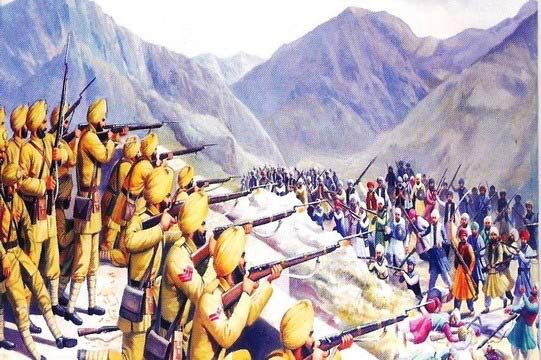12 Sep 1897: The Last Stand During Battle Of Saragarhi

Col Ajay Singh (retd)
Pune, 12th September 2021: Exactly 120 years ago, on 12 September 1897, 21 soldiers of the 36th SIKH Regiment (Later 1 SIKH and now 4 MECHANISED INFANTRY) fought an epic battle against 10,000 Afghans in an outpost known as Saragarhi post. This battle which often has been called the Thermopylae of India – saw each of the valiant Sikh defenders fall at their post.
Saragarhi was a small village in the North-West Frontier Province of Kohat – now in Pakistan. The British had been engaged in a yearlong campaign against the restive Pushtoon tribesmen and 36th SIKH had been recently raised to help quell the uprising. The Pushtoons had been repeatedly attacking British outposts, especially Fort Lockhart and Fort Gulistan on the Samana Ridge of the Hindu Kush mountains. Since the two forts were not inter-visible, a small post of Saragarhi was created midway to function as a heliographic communication post to relay signals between Fort Lockhart and Fort Gulistan.

The post was not much, just a small blockhouse and a signaling tower with a mud and stone wall around it on a rocky, wind-swept hill. As the Afghans stepped up their attacks on the British in August – September 1987, they launched repeated attacks on the forts of Lockhart and Gulistan only to be repulsed by the soldiers of 36th Sikh there. They then turned their attention to Saragarhi, hoping to sever communications. Fortuitously, the post had been reinforced just a day earlier and held 1 NCO (Havildar Ishar Singh) and 20 other ranks. On 12 September 1897, around 10,000 Pushtoons of the Afridi and Orakzai clans under their leader Gul Badshah surrounded the post and asked the small garrison to surrender, promising to let them free with their lives if they did. The soldiers conferred together and decided to fight till the last. The Afghan offer was rudely rebuffed.
At around 0900 hours the Afghans attacked the post. Two attacks were repulsed with heavy casualties. Each action was signaled back to Fort Lockhart, who though aware of the gravity of the situation, could not send any reinforcements there.
At around noon, the Afghans succeeded in breaching the outer wall, and the post commander Havildar Ishar Singh ordered the remnants of his men to fall back into the inner sanctum – the solitary mud and stone blockhouse that contained the signaling tower. He himself remained behind, firing to gain time for his men to withdraw, till he was overwhelmed by hordes of attacking Afghans.

The remnants of the post – now down to just a dozen or so- continued holding on inflicting heavy casualties on the enemy, till they were killed, one by one – many of them in hand-to-hand combat. Throughout the battle, signalman Gurmukh Singh continued relaying messages, providing an account of the unfolding battle to Fort Lockhart and Gulistan. In his last message, he sought permission to leave his signaling machine and join his comrades and fell with them when the Afghans finally broke through into the Communication tower.
It was only around 1600h or so that the last cries of ‘Bole Sone Nihal; Sat Sri Akal” and gunfire finally subsided. The Afghans suffered immensely during the battle and lost around 500-600. A battle which they thought would be over in an hour had taken all day. The heroic stand of Ishar Singh and his men gained time for reinforcements to reach Forts Lockhart and Gulistan and the Afghan attacks on the forts, the next day, were repulsed. Two days later, on 14th September, Saragarhi fort was also retaken by British reinforcements under cover of heavy artillery fire. Each of the 21 defenders were found dead at their posts. The Afghans had not mutilated them as they usually did, nor were their turbans removed – as a sign of honour, the Afghans accorded them for their courage.

The ruins of Saragarhi
Each of them was awarded the Indian Order of Merit – the highest gallantry award for an Indian soldier at that time – equivalent to the Victoria Cross and today’s Param Vir Chakra. The only such instance of collective bravery being recognized thus. To commemorate the battle, two Saragarhi Gurudwaras were constructed – one near the Golden Temple at Amritsar and the other at Ferozepur, where most of the soldiers were from. Saragarhi was a story of collective valour, of men fighting impossible odds, and then, even in death, remaining unbowed and undefeated.








